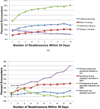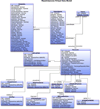The Analytic Information Warehouse (AIW): a platform for analytics using electronic health record data
- PMID: 23402960
- PMCID: PMC3660520
- DOI: 10.1016/j.jbi.2013.01.005
The Analytic Information Warehouse (AIW): a platform for analytics using electronic health record data
Abstract
Objective: To create an analytics platform for specifying and detecting clinical phenotypes and other derived variables in electronic health record (EHR) data for quality improvement investigations.
Materials and methods: We have developed an architecture for an Analytic Information Warehouse (AIW). It supports transforming data represented in different physical schemas into a common data model, specifying derived variables in terms of the common model to enable their reuse, computing derived variables while enforcing invariants and ensuring correctness and consistency of data transformations, long-term curation of derived data, and export of derived data into standard analysis tools. It includes software that implements these features and a computing environment that enables secure high-performance access to and processing of large datasets extracted from EHRs.
Results: We have implemented and deployed the architecture in production locally. The software is available as open source. We have used it as part of hospital operations in a project to reduce rates of hospital readmission within 30days. The project examined the association of over 100 derived variables representing disease and co-morbidity phenotypes with readmissions in 5years of data from our institution's clinical data warehouse and the UHC Clinical Database (CDB). The CDB contains administrative data from over 200 hospitals that are in academic medical centers or affiliated with such centers.
Discussion and conclusion: A widely available platform for managing and detecting phenotypes in EHR data could accelerate the use of such data in quality improvement and comparative effectiveness studies.
Copyright © 2013 Elsevier Inc. All rights reserved.
Figures








References
-
- Kocher R, Emanuel EJ, DeParle NA. The Affordable Care Act and the future of clinical medicine: the opportunities and challenges. Ann Intern Med. 2010;153:536–539. - PubMed
-
- Blumenthal D. Implementation of the federal health information technology initiative. N Engl J Med. 2011;365:2426–2431. - PubMed
-
- Blumenthal D. Wiring the health system--origins and provisions of a new federal program. N Engl J Med. 2011;365:2323–2329. - PubMed
-
- National Quality Measures Clearinghouse | Tutorial on Quality Measures. Agency for Healthcare Research and Quality. [(accessed 2012 Apr 3)]; http://www.qualitymeasures.ahrq.gov/tutorial/index.aspx. - PubMed
-
- Shahian DM, Wolf RE, Iezzoni LI, Kirle L, Normand SL. Variability in the measurement of hospital-wide mortality rates. N Engl J Med. 2010;363:2530–2539. - PubMed
MeSH terms
Grants and funding
LinkOut - more resources
Full Text Sources
Other Literature Sources

